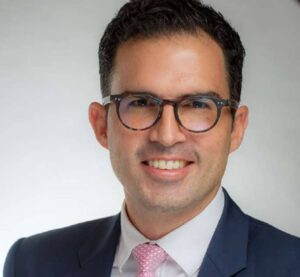
Elizabeth Moran interviewed Teiki Benveniste, Head of Ares Australia about the company’s outlook, preference for floating rate investments and the performance of Ares funds last year.
EM: Teiki, could you please share how you see floating rate securities in 2023 panning out in terms of interest rates, peak interest rates and inflation?
TB: I think the first thing to do is to set the scene and talk about the environment, what’s happening, and then our view going forward.

It’s very interesting because we are going into an environment where you look at leading economic indicators, and it’s pretty clear that a lot of people expect that we’re going to see a recession in the U.S. and probably a deeper one in Europe.
The main driver of this is the action of the central banks trying to fight inflation, raising rates, taking out amounts of liquidity that we’ve rarely seen in the history of financial markets. That leaves a big question mark on what is going to break, what is going to be the impact of that pull-back? This makes for a volatile environment for asset prices and as such we expect volatility to continue in 2023. The other thing that we can say, about the central bank action, is that if you read through what U.S. Fed Chair Powell has said, we believe the U.S. Federal Reserve will remain very focused on trying to fight inflation, but they’re also in a mindset where they’ve got the playbook to intervene if we do hit a recession. We believe their playbook is very much to fight inflation, but at the same time, they don’t want to have a recession on their hands that’s going to be too deep or too protracted. That’s probably a mitigating factor to how deep a recession could be in the U.S.
The other mitigating factor is the fact that we’re going into this potential recession with corporates, specifically below investment grade credit in much better health relative to other pre-crisis periods. This time around, when you look at fundamentals, most of those companies and credits have repaired their balance sheets after the COVID crisis. You see a lot of people commenting on the amount of debt taken on and how corporates are incredibly levered. When you actually look at the facts, what those corporates did is they went to the market, and locked in cheap costs of funding for five, six, seven or ten years.
The vast majority of maturities have been pushed out beyond 2024. That’s one less concern as we enter into 2023. The other thing that’s interesting is that when you look at the levels of leverage, they are low compared to historical levels and interest coverage ratios are high.
Also read: AU Inflation – A Report to Match Australia’s (Hot) Weather
While you’re entering into that volatile and potentially recessionary environment, companies are in much better shape than previous pre-recessionary periods. Further, the U.S. consumer, similar to corporates, has been able to improve its balance sheet, reduce its leverage, increase its savings and enters into a potentially more volatile time, or a recession, in a much stronger position than previous pre-recessionary periods. All of this tells us that yes, it’s likely that we are going to have a recession, but is it going to be a deep recession? Is it going to be a long recession? That’s not our base case.
For credit markets, our base case is that we will see default rates in the tradable, liquid, higher yielding parts of the market, including syndicated loans and high-yield bonds, revert to historical average levels of around 4-5%. At the same time, its possible interest rates remain higher for longer, which would benefit yields on floating rate assets, and on top of that, you’ve got your credit margin and origination fees if you’re able to self-originate, pushing available yields in the high single digit to low double-digit territory depending on your risk profile.
EM: I was just going to say, so you see a positive outlook for bonds in the coming year, two years? Do you have a view on or a preference between fixed and floating? Also, can you talk about derivatives?
TB: We don’t use derivatives too much to be honest. We achieve low duration in our funds from exposure to floating rate assets, not doing interest rate swap overlays. In general, we want our duration profile to come from our view on relative value between floating rate and fixed rate loans and bonds.
At the moment, we favor floating rate instruments from a relative value perspective. In traditional fixed income, the duration risk you’re taking for how much yield you’re getting is not necessarily very attractive on a relative value basis. For example, when you look at the Bloomberg Barclays Global Aggregate Index, the current yield has only gone up by 45 basis points in the last 12 months as of 31 December 2022 to 2.5%. Further, this part of the market experienced significant price volatility and was down over 15% in 2022.
We like floating rate assets because the rate hikes that have already been announced have not completely hit the coupon payments as they reset every three months, so we’re seeing our current yield really continuing to increase because of that base rate increase.
That doesn’t affect the price of those floating rate assets, but their income generation really increases. And that income cushion is so important in an environment that’s volatile. It’s a bit like in equities, value versus growth. You basically have a part of your total return coming from that steady income payment rather than price moves. That income cushion is bigger now than 12 months ago.
Of course, you’re taking credit spread risk, but most of your return should come from that income component. When you look at the self-originated private direct lending space, at the moment, we can generate 10-12% all-in yields on senior secured floating rate assets, at the highest point in the capital structure and floating rate for almost no duration risk.
EM: 12% is fabulous, do you want to talk a bit about the yields in your two funds?
TB: If you think about our daily liquid tradable strategy (Ares Global Credit Income Fund) where we invest only in tradable assets including syndicated loans that are private assets but tradable, high yield bonds, and collateralised loans obligations, which are not 2008 CDOs, that fund, which has about 60% invested in investment grade credit, has a current yield (AUD-hedged) of 5.7%, and a yield-to-maturity of 6.7% as of 31 December 2022.
While credit spreads have widened a little as well, it’s really the base rate that has helped the current yield increase over the last 12 months. The average price in the portfolio as of 31 December 2022 is 94.9 cents on the dollar, but it’s the coupon that’s providing most of that yield.
In the Ares Diversified Credit Fund (“ADCF”), which is investing across both the liquid and self-originated private direct lending platform where we can generate those 10-12% yields I’ve mentioned earlier, current yield is approximately 10.0% and yield to maturity is 11.3%.
For both of these portfolios, you’re buying yield, that is coming mainly from the coupon payment of the of floating rate instruments and then you’re buying those assets at a discount to face value, and in the case of ADCF, due to economics we’re able to generate for directly originating the asset, such as administrator and arranger fees. You’re building current yield and convexity in your potential returns.
EM: And sorry, Teiki, just remind me how much the minimum investment is on both funds and are they only available to wholesale investors as well?
TB: The Global Credit Income Fund is available to retail investors. It’s offered with the PDS and the minimum investment is $10,000. The Diversified Credit Fund on the other hand, is wholesale only and the minimum investment is $100,000.
Both of these funds try to target monthly distributions. The liquidity profile is the difference. We’re not going to give daily liquidity or monthly liquidity on asset classes we feel are not liquid. We are very happy to give daily liquidity in the Global Credit Income Fund because we’re investing in only tradable assets. The Diversified Credit Fund, at the moment, is invested about 80% in self-original assets by Ares. There isn’t really an active secondary market for those assets. We can’t really offer daily liquidity on that. We offer quarterly liquidity for the fund and hold 20% in tradable assets.
EM: Just going back, just another very general question, how do you guys see the 60/40 portfolio now from this point on? Has it had its day?
TB: I always go back to the fact that last year, the 60/40 model broke down. It broke down because both traditional fixed income and equities sold down at the same time. We’ve been in an environment where those fixed income assets have not generated that much income. What you’re taking is duration risk. You’re taking eight years of duration risk in the Barclays Global Aggregate Index and you have very little current income. You have less than 3% current income, which is still very low and not giving you much income cushion in terms of your total return. I think when you look at the 60/40 portfolio, what’s missing in there is that higher income generation, higher yielding part of the market which can provide that ballast.
When you look at the performance of our funds this year, it’s really been that higher-income generation that that’s been shielding our accounts. In the case of the Diversified Credit Fund, performance has been relatively stable for the last 12 months compared to the Barclays Global Aggregate Index, which has been down over 15%. And really a lot of this has come from the fact that the floating rates have adjusted up. Our income has increased and even though markets have been volatile, that income component has acted as the cushion and the ballast versus broader market volatility. We believe that every client is different, everyone has a different risk profile, but there is something to be considered when it comes to floating rate, senior secure assets for diversification and yield in your portfolio.
EM: Thank you very much, Teiki. Do you have anything you want to add?
TB: We’re trying to be at the tip of the spear for innovation on sustainability. Across our credit business, we’re actively engaging with portfolio companies on environmental, social and governance factors. Specific to ADCF, we have originated sustainability linked loans pursuant to which we set sustainability goals for the companies that we have lent to.

































